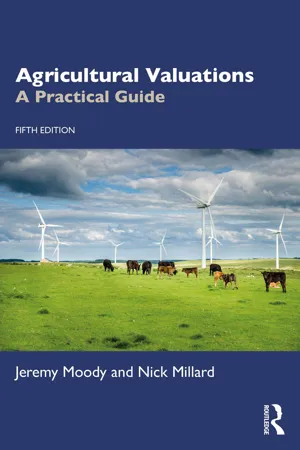
- 508 pages
- English
- ePUB (mobile friendly)
- Available on iOS & Android
About this book
Agricultural Valuations: A Practical Guide has long been the standard text for students and professionals working on agricultural valuations. Taking a practical approach, it covers all the relevant techniques and legislation necessary to correctly value farms, assess farm rents, carry out arbitrations, inventories and records of condition, including valuation clauses on sales of farms, livestock, soils, management agreements, valuation in court proceedings and a glossary of useful information.
In this fifth edition, Gwyn Williams's original text is taken on by Jeremy Moody and Nick Millard, renowned experts in the field, bringing the book right up to date to reflect recent changes in the rural economy, including development, diversification and renewable energy and specialist valuations and reference to all the latest legislation. Clear and accessible to students and professionals alike, readers will find Agricultural Valuations an invaluable guide to best practice in agricultural valuations.
Frequently asked questions
- Essential is ideal for learners and professionals who enjoy exploring a wide range of subjects. Access the Essential Library with 800,000+ trusted titles and best-sellers across business, personal growth, and the humanities. Includes unlimited reading time and Standard Read Aloud voice.
- Complete: Perfect for advanced learners and researchers needing full, unrestricted access. Unlock 1.4M+ books across hundreds of subjects, including academic and specialized titles. The Complete Plan also includes advanced features like Premium Read Aloud and Research Assistant.
Please note we cannot support devices running on iOS 13 and Android 7 or earlier. Learn more about using the app.
Information
Part 1 Foundations
2 Agricultural land
2.1 Land
2.2 Character of the land
- underlying geology
- type and depth of soil
- height above sea level, slope and aspect
- climate
- size and layout of fields
- boundaries with fences, walls, ditches, etc
- drainage
- contamination
- access
- proximity to markets
- fixed equipment
- dwellings
- buildings
- water supply
- vulnerability to flooding or drought
- other services (including for renewables, grid connection possibilities)
- public access
- exposure to and risks from intrusion, rabbits, deer, game damage, etc
- sporting opportunities
- state of repair, maintenance and management.
- obligations (such as to repair the chancel of the local church) or opportunities (first refusals) under the legal title
- restrictive covenants (real burdens in Scotland) and, potentially, commitments for conservation management
- reservation to others of an access route or other rights such as sporting or drainage over the land
- easements (servitudes in Scotland)
- rights taken by utilities.
2.3 Location and designations
- the country within the United Kingdom, each having its own legislation and approaches
- agricultural designations, including:
- whether in the Less Favoured Area (LFA) and so Severely Disadvantaged Area (SDA) (generally upland except for the Scilly Isles) or Disadvantaged Area (less material now). This can be relevant to access to rates of payments, such as the Scottish LFA Support Scheme (LFASS) and its headage payments
- direct payment region with the differing rates for area payments (currently Basic Payment)
- relevance and impact of cross compliance, greening and equivalent provisions of state agricultural policies
- inclusion in a Nitrate Vulnerable Zone
- environmental and landscape designations:
- National Parks (and areas with related designations such as the Norfolk Broads)
- Areas of Outstanding National Beauty (AONBs)
- Conservation Areas
- designations of buildings, structures, parks, etc. as listed for their historical, architectural or other interest
- Natura 2000 sites
- Ramsar sites
- National Nature Reserves
- Sites of Special Scientific Interest (SSSIs), called Areas of Special Scientific Interest (ASSIs) in Northern Ireland and the Isle of Man
- development control:
- is it in a Green Belt?
- is it brownfield land?
- is it with in the village envelope or other settlement boundary?
- how does the land sit within the local planning policies?
- the permitted development rights available and useful
- have permitted development rights been withdrawn (under Article 4 or equivalent powers in Scotland or Northern Ireland)?
- is it subject to planning restrictions because of issues such as a high-pressure gas main?
- public rights of way and open access provisions
- areas with particular costs, such as an Internal Drainage Board or other area with a drainage rate.
2.4 Buildings and fixtures
- providing a structure (often referred to as “tenant right”) at the end of the tenancy for compensating the outgoing tenant for what are then still growing crops, applied fertilisers and improvements to the soil, harvested crops (such as perhaps silage in the clamp), hefted hill sheep and some other works that must be left so that value is paid for what is left behind, encouraging the tenant to maintain the farm to the end
- disregarding at a rent review the generality of fixed equipment provided by the tenant (limited in Scotland to compensatable improvements) so that the tenant does not pay rent on the benefit of works the tenant has made.
3 Basic property law
3.1 Introduction
Table of contents
- Cover
- Half Title
- Title Page
- Copyright Page
- Contents
- Preface
- Foreword
- PART 1 Foundations
- PART 2 Valuations
- PART 3 Valuations for taxation, compulsory purchase, utilities and communications
- PART 4 Agricultural tenancies
- PART 5 Professional practice
- Appendices
- Index